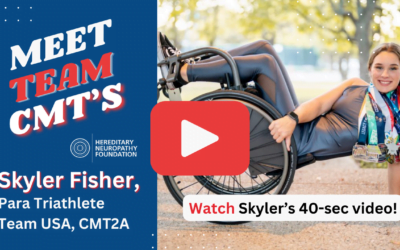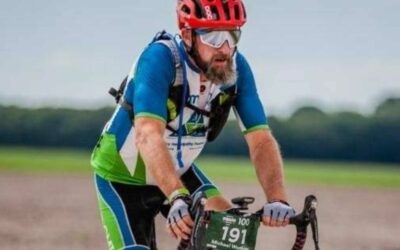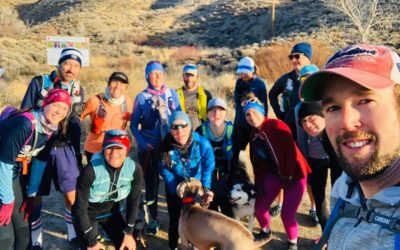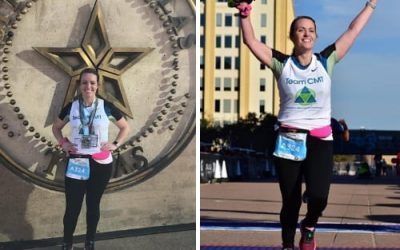 Like so many with Charcot-Marie-Tooth (CMT), Barb Vonada of Virginia tries to focus on what she can do, not on what she can’t. Recently, the 42 year old mom of three joined Team CMT- Richmond hoping to spread awareness and raise funds for research and a cure. “I’m at a point in my life now where I want to put my energies into what is most central. I want to meet people like me and talk about the challenges of CMT.” Barb hopes her involvement with Team CMT will help emphasize the importance of exercise for anyone diagnosed with CMT. Aware that it is a progressively degenerative disease that will continue to challenge her, Barb wants to begin a support group that will “give me and others with CMT who struggle with mobility issues an opportunity to be around similar people with the same day-to-day struggles.”
Like so many with Charcot-Marie-Tooth (CMT), Barb Vonada of Virginia tries to focus on what she can do, not on what she can’t. Recently, the 42 year old mom of three joined Team CMT- Richmond hoping to spread awareness and raise funds for research and a cure. “I’m at a point in my life now where I want to put my energies into what is most central. I want to meet people like me and talk about the challenges of CMT.” Barb hopes her involvement with Team CMT will help emphasize the importance of exercise for anyone diagnosed with CMT. Aware that it is a progressively degenerative disease that will continue to challenge her, Barb wants to begin a support group that will “give me and others with CMT who struggle with mobility issues an opportunity to be around similar people with the same day-to-day struggles.”
It wasn’t until recently that Barb felt CMT had much of an effect on her life. As a child, she was aware that her hands and feet looked different. She remembers her mom Ruth “walked funny and her hands were weak. She couldn’t work buttons or braid my or my sister’s hair.” Barb also has memories of her grandfather Kenneth Hall, Ruth’s father, sitting in a wheelchair in leg braces with huge shoes. His hands closed to the point of barely being usable. Voicing a sentiment typical of families with CMT, Barb said, “Although everyone knew there was a problem, we never talked about it.” Formally diagnosed in 1999, Barb still felt CMT wasn’t really affecting her life. She was, and is, able to run and participate in triathlons. And, she didn’t give much attention to the items that kept slipping through her hands. After all, in Barb’s family dropping items isn’t that unusual; 12 of Barb’s 28 family members have some degree of impairment due to CMT. The diagnosis, however, gave Barb a focus. “I don’t know what it is like to walk normally or not drop things. But once there was a diagnosis, I knew why I couldn’t do those things. And it made me concentrate on what I could do.”
When she was in high school, Barb played the tuba. While attending a high school regional band festival she met Calvin, her husband of 22 years. He was a trumpet player for a rival school. Later that year, Calvin enlisted in the Army as a military musician. Following graduation, Barb enlisted as a tuba player. She and Calvin were married in January 1989. Following her enlistment, Barb joined the Army Reserve band in Richmond, VA, until 1998 when the family moved to Heidelberg, Germany. Because there wasn’t an Army Reserve band in Germany, Barb reclassified, eventually working in human services. Along with their growing family, they lived in various places around the world until Calvin’s retirement in 2007.
In 2003 Barb was commissioned as a second lieutenant. She was called to serve in Iraq as a Human Resources Officer leading a postal detachment out of New York. Barb spent more than a year overseeing the operations of four postal facilities in Southern Iraq, which required her to travel between bases surrounded by combat. As CMT affected her hands, Barb would have to ask her battle buddy to secure her straps and pull the hand guards up on her M16 automatic rifle.
“The stress of the deployment impacted my CMT, and I experienced a noticeable difference in my gait, balance, muscle weakness and fatigue.” As a mom she admits “the hardest part of being in Iraq was being separated from my family.” In 2009 after 15 years of service Barb left the military.
She continues to work and to train, which includes running, her least favorite part of a triathlon. “I have a love/hate relationship with running. Biking is my favorite part of the triathlon, and swimming is okay. But, the running…I always ask ’can we eliminate the running?’” When she runs, Barb must concentrate on putting one foot in front of the other and hitting the pavement in such a way as to avoid falling. Barb knows that by the time she feels pain, she has sustained an injury, so she relies on sound to determine when to stop. “When the sound of my feet hitting the pavement begins to get louder, I know it is time to quit.” What would make someone who hates running continue to do it? “There is a significant [negative] difference with my level of fatigue and ankle problems when I’m not doing it,” she explains.
Barb is aware that some of her CMT symptoms have gotten worse. “I suffer from restless leg syndrome, weakness and tingling in my hands and ankles, constant tripping and balance issues. I tire quickly. I have muscle atrophy below the knee and am currently battling tight calf muscles.” Deep massage is helpful as is using a rolling pin-style device called The Stick for runners, which is available online. Cold weather is an enemy, causing her muscles to ache, her hands to stop working and her feet to go numb. Barb has to focus hard when walking to avoid falling. CMT has started to interfere with her hobbies as well. Over the years Barb has given up embroidery and counted cross stitch because it is too difficult to maneuver the needle and thread. She is about to give up knitting which has become too tiring for her hands. She does enjoy sewing and quilting most of which is done on a machine. When it is time to hand stitch the binding, Barb really has to force her way through it. “My hands tire quickly and ache after hand stitching and I drop the needle a lot. So when I get very frustrated I know I have to put it down and do something else until I can return to it. I get the stitching done but I’m slower and I suffer from bouts of frustration.” In the same way Barb knows she must exercise and run to maintain some function in her legs, she knows she must force herself through the hand stitching to keep her hands working.
Barb acknowledges there will probably be a time when she won’t be able to run anymore. She already knows what she will do: “When that happens, I will go from being an athlete to a cheerleader for Team CMT. I am highly interested in growing the cheerleading squad. I see it as an outlet for those of us with CMT who are challenged with mobility issues to meet each other, share ideas and coping strategies while we encourage the team runners.” Call it a cheerleading squad or a support group; it doesn’t matter. What matters is creating awareness and acceptance of CMT and working together to encourage everyone with CMT to live life to the fullest. With determination and leadership like Barb’s that message comes through loud and clear.












0 Comments